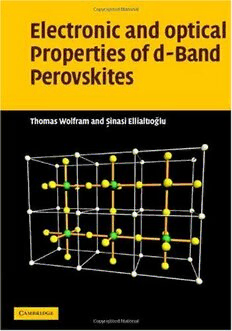
Electronic and optical properties of D-band perovskites PDF
Preview Electronic and optical properties of D-band perovskites
This page intentionally left blank T. WOLFRAM AND S. ELL˙IALTIOG˘ LU ElectronicandOpticalPropertiesofd-bandPerovskites The perovskite family of oxides includes a vast array of insulators, metals, and semiconductors.Currentintensescientificintereststemsfromthelargenumberof diversephenomenaexhibitedbythesematerialsincludingpseudo-two-dimensional electronicenergybands,high-temperaturesuperconductivity,metal–insulatortran- sitions,piezoelectricity,magnetism,photochromicandcatalyticactivity. This book is the first text devoted to a comprehensive theory of the solid-state properties of these fascinating materials. The text includes complete descriptions of the important energy bands, photoemission, and surface states. The chapter on high-temperature superconductors explores the electronic states in typical copper oxide materials. Theoretical results are compared with experimental results and discussedthroughoutthebook. With problem sets included, this is a unified, logical treatment of fundamen- tal perovskite solid-state properties, which will appeal to graduate students and researchersalike. Thomas Wolfram is a retired professor and Chairman of the Department of Physics and Astronomy at the University of Missouri-Columbia and retired Vice PresidentandGeneralManagerofAmocoLaserCompany,ATX. S¸˙inas˙i Ell˙ialtiog˘ luisaprofessorandformerChairmanoftheDepartment ofPhysicsattheMiddleEastTechnicalUniversity,Ankara,Turkey. P1:FXS/GQE P2:FXS CUUK735-Wolfram August9,2006 2:57 ELECTRONIC AND OPTICAL PROPERTIES OF D-BAND PEROVSKITES THOMAS WOLFRAM FormerlyofUniversityofMissouri-Columbia S¸ ˙INAS˙I ELL˙IALTIOG˘ LU MiddleEastTechnicalUniversity,Ankara iii CAMBRIDGEUNIVERSITYPRESS Cambridge, New York, Melbourne, Madrid, Cape Town, Singapore, São Paulo Cambridge University Press The Edinburgh Building, Cambridge CB28RU, UK Published in the United States of America by Cambridge University Press, New York www.cambridge.org Information on this title: www.cambridge.org/9780521850537 © T. Wolfram and S. Ellialtioglu 2006 This publication is in copyright. Subject to statutory exception and to the provision of relevant collective licensing agreements, no reproduction of any part may take place without the written permission of Cambridge University Press. First published in print format 2006 ISBN-13 978-0-511-34949-2 eBook (NetLibrary) ISBN-10 0-511-34949-1 eBook (NetLibrary) ISBN-13 978-0-521-85053-7 hardback ISBN-10 0-521-85053-3 hardback Cambridge University Press has no responsibility for the persistence or accuracy of urls for external or third-party internet websites referred to in this publication, and does not guarantee that any content on such websites is, or will remain, accurate or appropriate. Contents Preface page ix 1 Introductory discussion of the perovskites 1 1.1 Introduction 1 1.2 The perovskite structure 3 1.3 Ionic model 4 1.4 Madelung and electrostatic potentials 6 1.5 Covalent mixing 9 1.6 Energy bands 12 1.7 Localized d electrons 16 1.8 Magnetism in the perovskites 17 1.9 Superconductivity 18 1.10 Some applications of perovskite materials 20 2 Review of the quantum mechanics of N-electron systems 27 2.1 The Hamiltonian 27 2.2 The Slater determinant state 28 2.3 Koopman’s theorem 29 2.4 Hartree–Fock equations 30 2.5 Hartree–Fock potential 32 2.6 Approximate exchange potential 34 2.7 The LCAO method 35 2.8 Orthogonalized atomic orbitals 37 v vi Contents 3 Empirical LCAO model 41 3.1 LCAO matrix elements 41 3.2 Slater–Koster model 42 3.3 Symmetry properties of the L¨owdin orbitals 48 4 LCAO energy band model for cubic perovskites 53 4.1 The unit cell and Brillouin zone 53 4.2 LCAO matrix equation for an infinite lattice 56 4.3 LCAO matrix elements for the perovskite 57 4.4 LCAO eigenvalue equation for the cubic perovskites 61 4.5 Qualitative features of the energy bands 65 4.6 Summary of the chapter results 73 5 Analysis of bands at symmetry points 77 5.1 Energy bands at Γ 77 5.2 Energy bands at X 81 5.3 Energy bands at M 84 5.4 Energy bands at R 86 5.5 Cluster electronic states 90 6 Density of states 107 6.1 Definitions 107 6.2 DOS for the pi bands 109 6.3 DOS for the sigma bands 114 6.4 The Fermi surface and effective mass 123 7 Optical properties of the d-band perovskites 138 7.1 Review of semiclassical theory 139 7.2 Qualitative theory of ε (ω) 142 2 7.3 Interband transitions from non-bonding bands 153 7.4 Frequency dependence of ε (ω) for 2 insulating and semiconducting perovskites 157 7.5 Frequency dependence of ε (ω) 2 from σ0 →π∗ transitions 167 Contents vii 7.6 Frequency dependence of ε (ω) 2 from π →π∗ transitions 170 7.7 σ →π∗ interband transitions 173 7.8 Summary 180 8 Photoemission from perovskites 182 8.1 Qualitative theory of photoemission 183 8.2 Partial density of states functions 187 8.3 The XPS spectrum of SrTiO 189 3 8.4 Na WO 192 x 3 8.5 Many-body effects in XPS spectra 193 9 Surface states on d-band perovskites 199 9.1 Perturbations at a surface 199 9.2 Surface energy band concepts 202 9.3 Self-consistent solutions for the band-gap surface states: SrTiO 213 3 9.4 Surface–oxygen defect states 221 10 Distorted perovskites 231 10.1 Displacive distortions: cubic-to-tetragonal phase transition 231 10.2 Octahedral tilting 240 11 High-temperature superconductors 249 11.1 Background 249 11.2 Band theory and quasiparticles 253 11.3 Effective Hamiltonians for low-energy excitations 256 11.4 Angle-resolved photoemission 257 11.5 Energy bands of the Cu–O layers 260 2 11.6 Chains in YBa Cu O 277 2 3 6.95 11.7 Summary 279 viii Contents Appendices A Physical constants and the complete elliptic integral of the first kind 285 A.1 Selected physical constants 285 A.2 The complete elliptic integral of the first kind 286 B The delta function 288 C Lattice Green’s function 291 C.1 Function G (0) 293 ε C.2 Function G (1) 294 ε C.3 Lattice Green’s function for the pi bands 296 D Surface and bulk Madelung potentials for the ABO structure 302 3 Index 305
